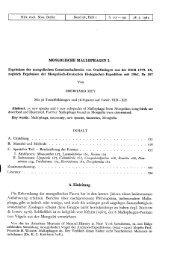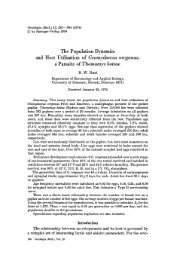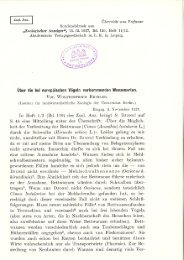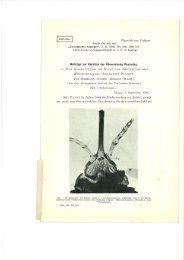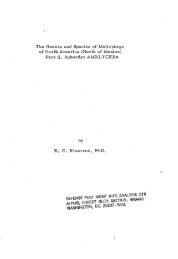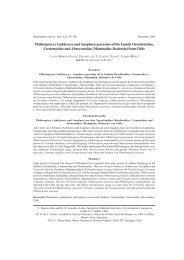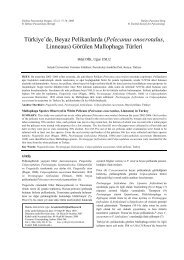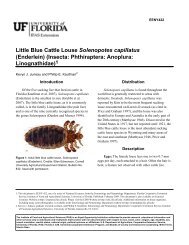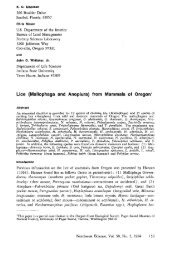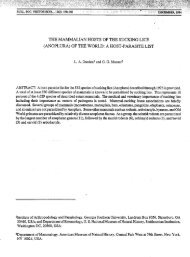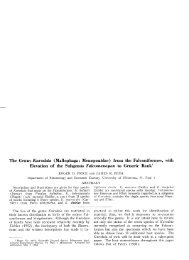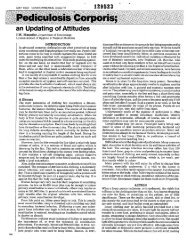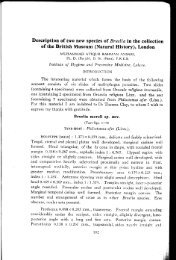The Geographical and Ecological Distribution of Arboreal Psocoptera
The Geographical and Ecological Distribution of Arboreal Psocoptera
The Geographical and Ecological Distribution of Arboreal Psocoptera
Create successful ePaper yourself
Turn your PDF publications into a flip-book with our unique Google optimized e-Paper software.
Annu. Rev. Entomol. 1985.30:175-196. Downloaded from arjournals.annualreviews.org<br />
by Mr. Bas van Berkum on 10/10/07. For personal use only.<br />
Annual Reviews<br />
www.annualreviews.org/aronline<br />
188 THORNTON<br />
between 2440 <strong>and</strong> 3200 m. Mesopsocus montanus, found in the Erica zone<br />
(3320-3660 m), occurs at similar heights on Kilimanjaro.<br />
<strong>The</strong> effect <strong>of</strong> altitude on psocid distribution can perhaps best be examined by<br />
studying the fauna <strong>of</strong> a single tree species that has a sufficiently wide altitudinal<br />
range. On mango in Jamaica an increase in diversity <strong>of</strong> 3.3 species per 300 m<br />
increase in altitude from 150 to 1220 m was found (100). Over this range more<br />
high-altitude stenotopes were added as species were replaced by close relatives<br />
at successively higher, less disturbed habitats. About 95% <strong>of</strong> the high altitude<br />
stenotopes were endemic, in contrast to 50% <strong>of</strong> those from regions below about<br />
600 m. Such confinement <strong>of</strong> endemics to native highl<strong>and</strong> vegetation is common<br />
on many tropical isl<strong>and</strong>s. As in the Hagenia zone <strong>of</strong> Mount Kenya, psocids<br />
were extremely sparse in Jamaica from 1200 to 2300 m; at these altitudinal<br />
ranges, humidities are extremely high <strong>and</strong> bryophytes <strong>and</strong> hymenophyllous<br />
ferns replace the lichens <strong>of</strong> the lower sclerophyll forest. A marked reduction in<br />
psocid numbers <strong>and</strong> diversity is also characteristic <strong>of</strong> mountain tops with wet<br />
conditions <strong>and</strong> epiphytic mosses in many parts <strong>of</strong> the Pacific. On mango in<br />
Trinidad the psocid fauna was more diverse, but the same general trends were<br />
apparent over the range <strong>of</strong> altitudes studied (0 to 610 m) (19).<br />
In Yorkshire, Engl<strong>and</strong>, the fauna <strong>of</strong> larch was studied from near sea level to<br />
400 m (16). In contrast to the Caribbean studies, no change in species numbers<br />
or species replacement was found, but density increased markedly with altitude.<br />
Mesopsocus unipunctatus was found to occur at both low <strong>and</strong> high<br />
elevations (above 260 m), whereas its close relative M. immunis, believed to be<br />
at the northern end <strong>of</strong> its range, was confined to lower altitudes. Greater winter<br />
loss <strong>of</strong> egg batches <strong>and</strong> greater sensitivity to low temperatures in regard to<br />
oviposition were suggested as possible critical factors in deternfining the<br />
absence <strong>of</strong> M. immunis from the higher forests (23). Elipsocus mclachlani, a<br />
facultative lichen feeder, was found only above 200 m, but the six other<br />
common species were eurytopic.<br />
On Kauai Isl<strong>and</strong>, Hawaiian Isl<strong>and</strong>s, I collected some 34 species from Acacia<br />
koa from 500 to 1200 m on the Kokee massif over a period <strong>of</strong> a few days. Of<br />
these, seven could be considered eurytopic (occurring from 650 to 1200 m) six<br />
were only taken from 800 to 950 m, nine from 800 to 1200 m (four most<br />
common at 1200 m), <strong>and</strong> nine only on the Kokee plateau at about 1200 m. Eight<br />
<strong>of</strong> the high altitude stenotopes were endemics, including all five species <strong>of</strong> the<br />
endemic genus Palistreptus found in this transect.<br />
TREES AS HABITATS <strong>The</strong>re is evidence that the psocid faunal spectrum on<br />
trees varies considerably according to the type <strong>and</strong> species <strong>of</strong> tree, even in the<br />
same locality.<br />
Tree "preferences" In Europe, a broad division between associations on<br />
coniferous <strong>and</strong> broad-leaved trees is generally accepted. Although similar in



